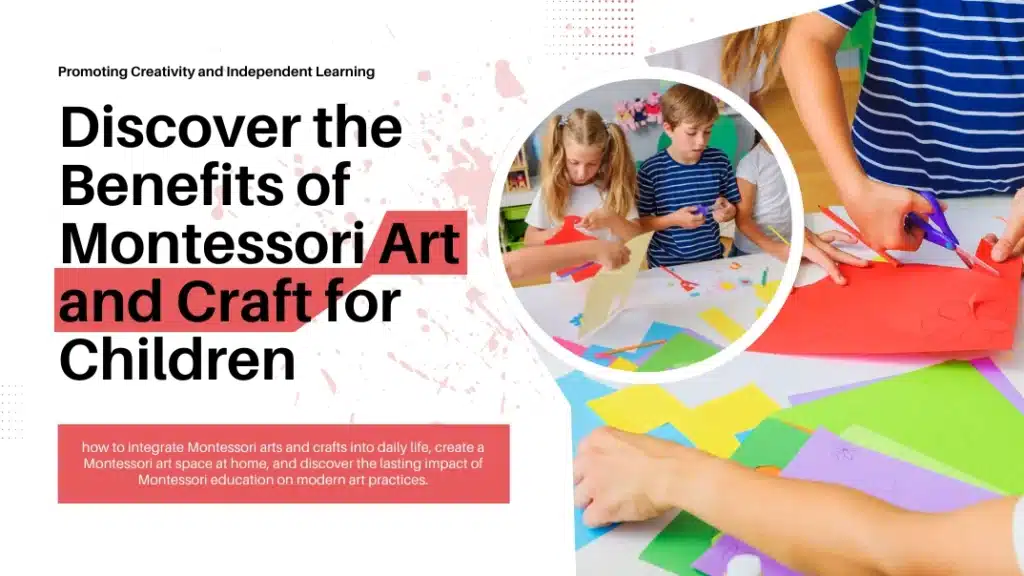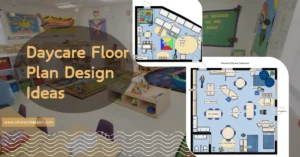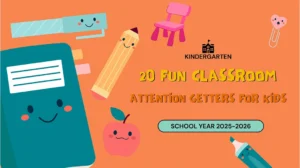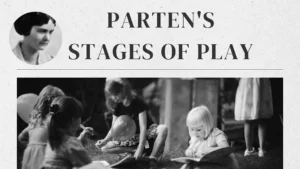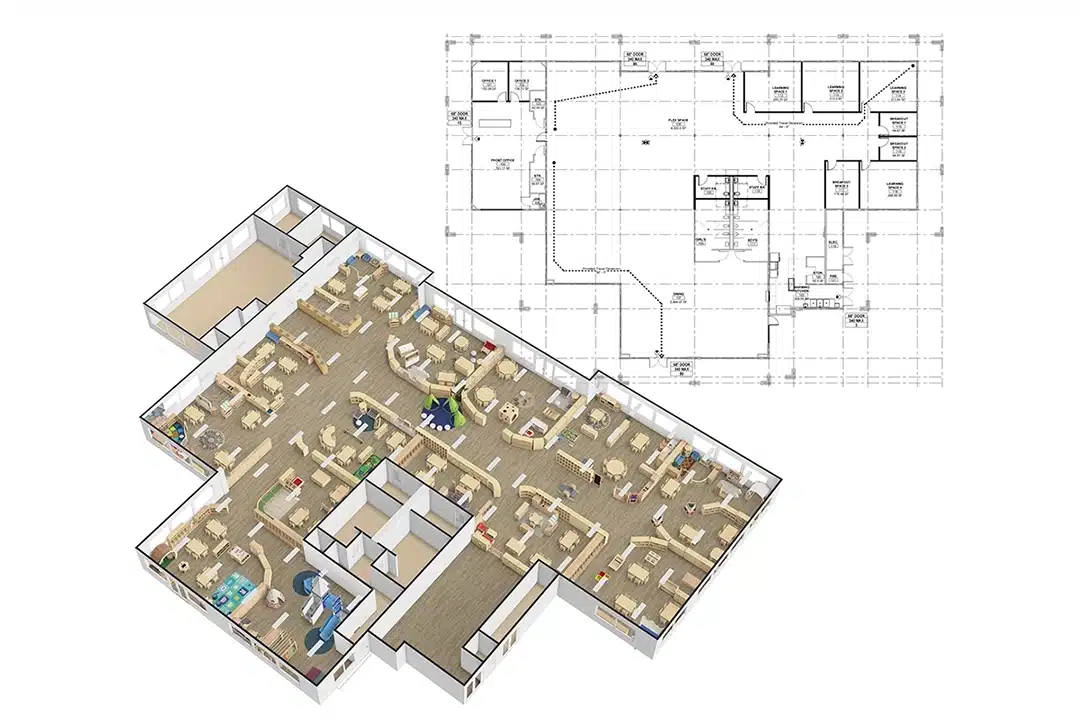Every child is born with an innate sense of creativity and a natural urge to explore colors, shapes, and textures. But in today’s fast-paced world, many children are boxed into structured lessons focusing more on results than the joy of creation. Traditional arts and crafts activities often emphasize following instructions rather than fostering creativity, making children more concerned about getting things “right” instead of expressing themselves freely.
This is where Montessori arts and crafts stand apart. Unlike conventional approaches, Montessori art encourages children to explore materials independently, make creative decisions, and focus on the process rather than the final product. However, implementing Montessori arts and crafts activities can feel overwhelming for many parents and educators. What materials should you use? How much guidance should you provide? And how do you strike the perfect balance between freedom and structure?
The good news is creating a Montessori-inspired art environment is easier than you think. By understanding the philosophy behind Montessori arts and crafts, choosing the right materials, and introducing engaging arts and crafts ideas for Montessori, you can help children develop creativity, independence, and fine motor skills—all while making art a joyful, stress-free experience. In this guide, we’ll explore everything you need to know about Montessori art and craft, from its benefits to practical, hands-on activities that bring out the artist in every child.
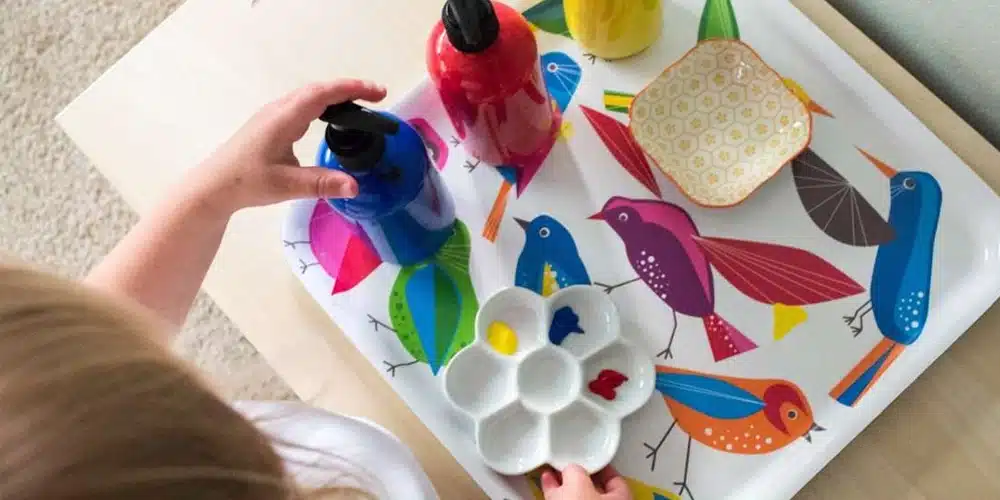
What is the Montessori Approach to Art and Craft?
From the moment they start scribbling on paper (or sometimes the walls!), they express thoughts, emotions, and ideas that words cannot always capture. However, traditional art education often imposes rigid guidelines—color within the lines, follow the template, and stick to the instructions. While sometimes helpful, this structured approach can limit a child’s ability to explore, create, and think independently.
This is where Montessori art and craft takes a different approach. Instead of focusing on predefined outcomes, the Montessori method values process over product, allowing children to engage with art in a natural way. Whether painting freely, experimenting with clay, or using unconventional materials, Montessori-inspired activities encourage children to follow their curiosity rather than conforming to fixed expectations.
Key Principles of Montessori Art and Craft
The Montessori approach to art and craft Montessori is rooted in several core principles:
- Process over Product—The emphasis is on the creative experience rather than achieving a “perfect” final piece. Children are encouraged to explore materials, textures, and techniques without worrying about making something that looks “right.”
- Freedom of Choice – Unlike conventional settings where teachers dictate the steps, Montessori allows children to choose their materials, colors, and methods, fostering independence and decision-making.
- Hands-On Learning – Art is deeply sensory. Montessori children engage in activities that develop fine motor skills, hand-eye coordination, and spatial awareness.
- Minimal Adult Intervention – Teachers and parents act as guides rather than instructors, giving children the space to experiment, make mistakes, and learn through experience.
Focus on Independent Learning
One key aspect of Montessori arts and crafts ideas is self-directed exploration. Instead of handing children a step-by-step project, Montessori educators provide an inviting environment where children decide what to create, how to make it, and when they feel their work is complete.
For example, rather than giving a child a coloring book, a Montessori classroom might offer blank paper, watercolor paints, pastels, and natural materials like leaves and twigs. The children can then decide what to draw, what colors to mix, and how they want to express themselves. This approach nurtures creativity and problem-solving skills and builds self-confidence—children take pride in their work because it is entirely their own.
What Does Montessori Say About Art?
Dr. Maria Montessori saw art as essential to a child’s development. She believed art should be a natural extension of a child’s learning experience, not a separate or structured lesson. Her philosophy was based on the idea that children, when given the freedom to explore, would naturally engage with artistic expression in meaningful ways.
Art as a Means of Self-Expression
In Montessori education, art is not just about making something pretty—it’s about communication. Young children often lack the vocabulary to express their emotions and thoughts fully, but through Montessori art and craft activities, they can convey their feelings, ideas, and imagination in ways that words sometimes fail to capture.
For instance:
- A child frustrated about something might paint bold, heavy strokes with deep colors, unconsciously expressing their emotions.
- Another child might create intricate patterns with clay, showing their attention to detail and patience.
By allowing children to explore different artistic mediums freely, Montessori encourages self-awareness and emotional growth in a way that traditional education often overlooks.
Fostering Creativity in Early Childhood
One of the most significant advantages of Montessori arts and crafts is that it fosters creativity from an early age. Montessori art is open-ended, unlike structured craft projects that follow a fixed outcome. Children are encouraged to:
- Mix colors freely without being told which combinations “look best.”
- Use unconventional tools (like feathers, sponges, or even their fingers) to paint.
- Incorporate nature into their work—leaves, stones, and twigs can become part of their artistic exploration.
This unrestricted creativity nurtures a child’s imagination, critical thinking, and decision-making skills—all crucial for overall cognitive development.
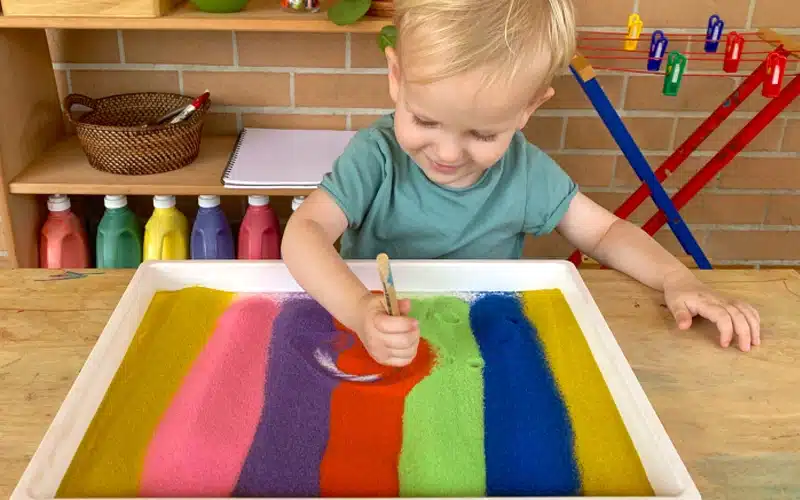
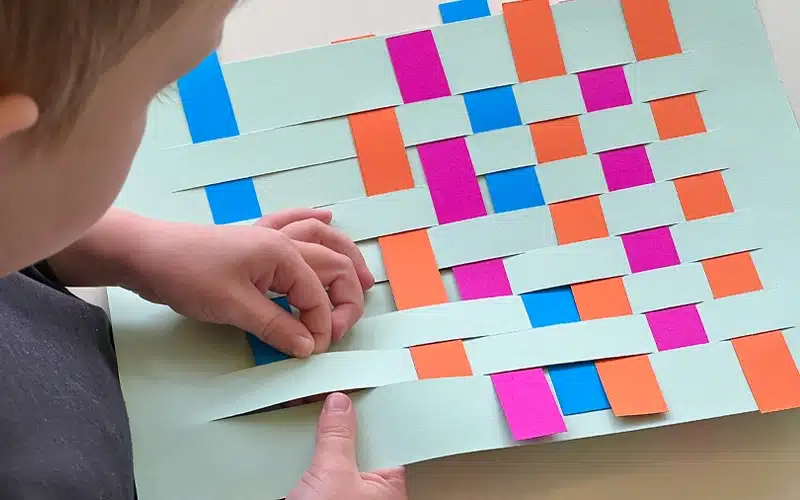
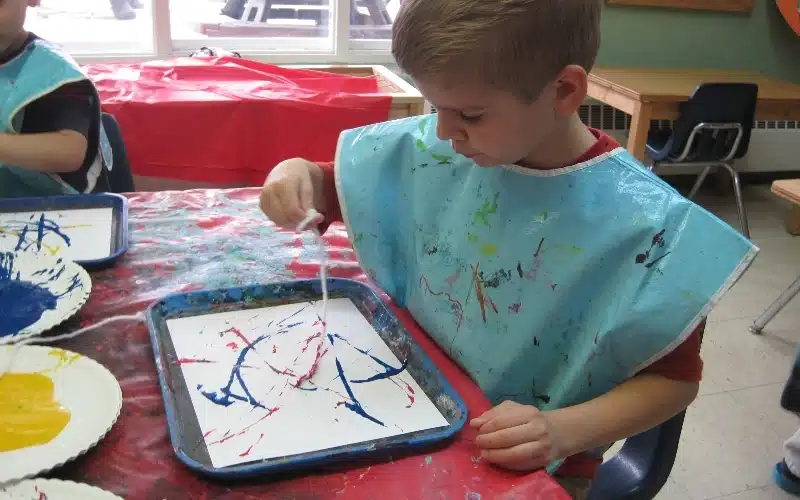
Why Is Art and Craft Important in Child Development?
Many people think of art as just a fun pastime for kids, but in reality, Montessori art and craft play a significant role in child development. Engaging in hands-on, creative activities has profound benefits, from cognitive growth to emotional well-being.
Enhancing Cognitive and Motor Skills
When children engage in art and craft Montessori activities, they are doing much more than just making pretty pictures. They are:
- Strengthening their fine motor skills by gripping paintbrushes, cutting paper, and molding clay.
- Developing hand-eye coordination through drawing, assembling, and arranging materials.
- Learning about patterns, symmetry, and spatial relationships—all of which contribute to mathematical thinking.
For example, cutting paper into different shapes and gluing them into a collage isn’t just a fun craft—it’s also helping a child develop spatial awareness and problem-solving skills.
Emotional Expression and Social Interaction
Art is an incredible tool for emotional development. When children engage in Montessori art and craft activities, they learn to:
- Healthily express emotions—joy, frustration, excitement, or sadness.
- Build patience and concentration—as they work through challenges, like blending colors or assembling a sculpture.
- Improve social skills—especially when collaborating with others on group art projects.
For example, in a Montessori classroom, children might work together on a large mural, each contributing their unique part. This enhances their artistic skills and teaches them cooperation, respect for others’ ideas, and teamwork.
Art Activities vs. Craft Activities
Art and craft are often used interchangeably, but they serve distinct purposes in Montessori education. While both activities nurture creativity and fine motor skills, art activities focus on self-expression, while craft activities emphasize structure and goal-oriented creation. Understanding the differences can help educators and parents create a balanced environment that fosters creativity and practical skill development.
The Focus of Art Activities
In Montessori art and craft, art activities are open-ended, meaning no predefined outcome exists. Children are encouraged to freely explore materials, experiment with colors, and express their emotions without being confined by rigid instructions. The focus is on process over product, allowing children to engage in pure creativity.
Characteristics of Montessori Art Activities:
- No fixed result – Every child’s artwork is unique, with no “correct” way to complete it.
- Encourages self-expression – Helps children communicate their thoughts, feelings, and experiences.
- Sensory-rich experience – Uses various textures, colors, and tools to enhance fine motor skills.
For example, a child given watercolor paints and a blank canvas in a Montessori art and craft album can create whatever inspires them. There is no expectation of painting a specific object; instead, they can explore blending colors, making abstract patterns, or even finger-painting for a more tactile experience.
The Goal-Oriented Nature of Craft Activities
Unlike open-ended art, craft activities have a structured approach where children follow steps to create a specific item. While they still allow for some creativity, they also introduce problem-solving, sequencing, and precision skills.
Characteristics of Montessori Craft Activities:
- Defined objective – Children work towards making a finished product (e.g., a paper lantern, beaded bracelet).
- Fine motor skill development – Cutting, gluing, and assembling materials improve hand-eye coordination.
- Foster’s patience and concentration – Following steps teaches children discipline and perseverance.
For instance, a child working on a Montessori-inspired nature collage may be guided to collect leaves, press them onto paper, and glue them visually pleasingly. While the materials and some design choices are up to the child, the goal is to create a completed collage.
Which One is Better?
Neither is “better”—both are essential in Montessori education. Art activities fuel creativity, while craft activities provide structure and skill-building. A balanced approach ensures that children get the best of both worlds, developing their imagination and practical abilities.
Comparison of Art Activities vs Craft Activities
| Feature | Art Activities | Craft Activities |
|---|---|---|
| Focus | Self-expression and creativity | Skill-building and structured creation |
| Process vs. Product | Focuses on the process rather than the final result | Aimed at creating a specific final product |
| Instructions | Open-ended, child-led exploration | Often involves step-by-step instructions |
| Creativity Level | Fully creative and unique; no right or wrong | Creativity within a defined framework |
| Motor Skills Developed | Fine motor coordination, sensory exploration | Precision, patience, and dexterity |
| Examples | – Free painting with watercolors – Abstract drawing with crayons – Clay sculpting without a set design | – Making a beaded bracelet – Creating a paper collage with a specific theme – Folding origami following instructions |
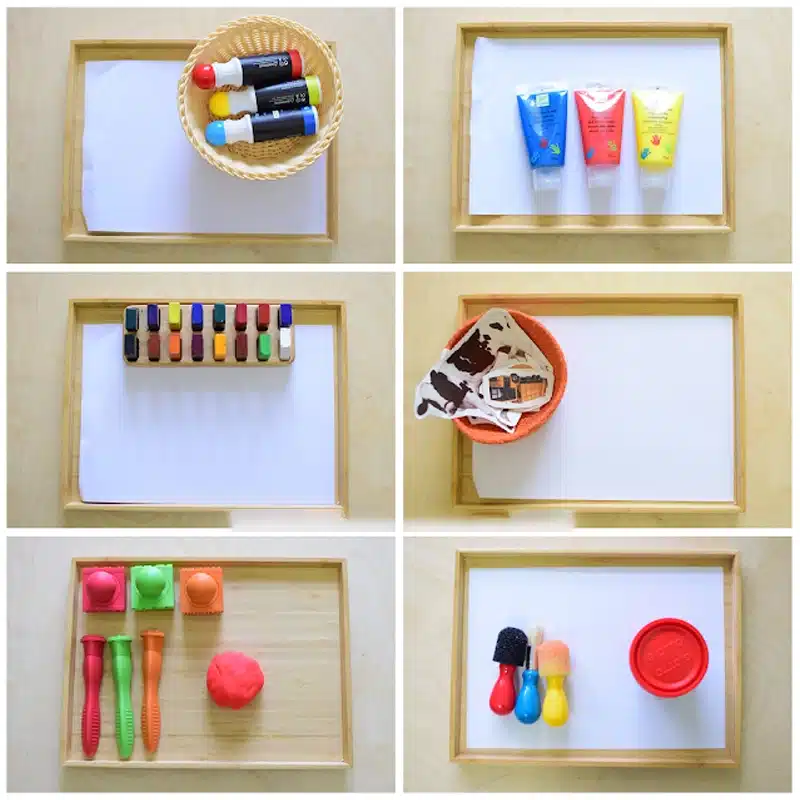
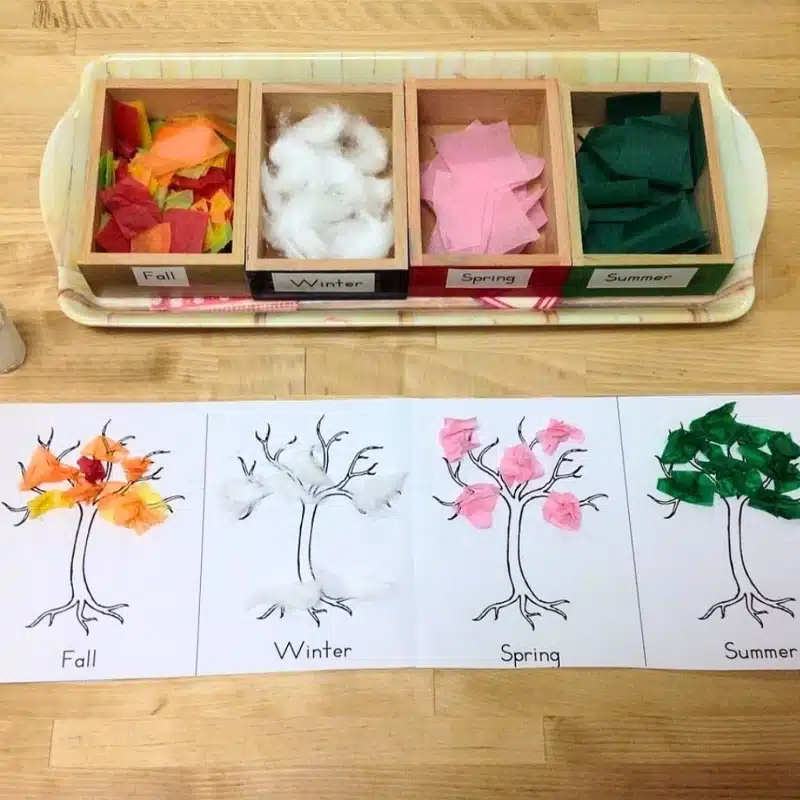

Materials for Montessori Art and Craft
In Montessori art and craft, choosing the right materials is as important as the creative process. Unlike traditional craft kits that provide pre-made templates, Montessori materials emphasize hands-on exploration, sensory engagement, and open-ended creativity.
Key Features of Montessori Art and Craft Materials:
Natural and Realistic—Encourage the use of real materials like wood, fabric, and clay instead of synthetic plastics.
Open-Ended – Materials should inspire creativity rather than dictate the outcome.
Safe and Eco-Friendly – Montessori values sustainability, so non-toxic, biodegradable, and reusable materials are preferred.
| Material Type | Examples | Recommended Age | Benefits |
|---|---|---|---|
| Basic Drawing & Painting Tools | Beeswax crayons, watercolor paints, charcoal pencils, natural brushes | 2+ years | Develops fine motor skills, hand-eye coordination, and creativity |
| Natural & Organic Materials | Wooden sticks, leaves, flowers, seashells, stones, tree bark | 1+ years | Encourages sensory exploration and connection with nature |
| Clay & Sculpting Materials | Natural clay, beeswax modeling clay, homemade playdough | 2+ years | Enhances tactile learning and hand strength |
| Textile & Fabric-Based Materials | Wool, felt, cotton scraps, yarn, embroidery thread | 3+ years | Supports textile arts, sewing skills, and precision |
| Recycled & Sustainable Materials | Newspaper, cardboard, egg cartons, old magazines, paper rolls | 4+ years | Teaches sustainability, problem-solving, and crafting skills |
| Gluing & Binding Tools | Child-safe glue, non-toxic paste, washi tape, wooden clips | 3+ years | Strengthens precision, hand coordination, and patience |
| Cutting & Shaping Tools | Child-friendly scissors, hole punches, wooden carving tools (for older kids) | 4+ years | Enhances dexterity and grip control |
| Beading & Threading | Wooden beads, large-hole buttons, natural seeds, macrame cords | 3+ years | Builds fine motor skills, concentration, and hand-eye coordination |
| Printing & Stamping Materials | Natural sponges, carved potatoes (for stamping), block printing tools | 4+ years | Encourages pattern recognition and imaginative design |
Natural and Non-Toxic Materials
A core principle of Montessori arts and crafts is using safe and sustainable materials. Montessori encourages using eco-friendly, real-world materials instead of relying on synthetic or mass-produced materials.
- Non-Toxic Paints and Dyes – Water-based paints or vegetable dyes ensure child safety.
- Wooden Tools Instead of Plastic – Helps children connect tactilely with natural elements.
- Eco-Friendly Adhesives – Homemade glue (like flour paste) or natural rubber-based adhesives.
- Organic Fibers – Cotton, wool, and silk provide a rich sensory experience.
By using Montessori-inspired materials, children enhance their artistic abilities and develop an appreciation for nature and sustainable living.
Choosing Materials for Different Age Groups
Different age groups require other materials to match their developmental needs. The right materials challenge but do not frustrate a child, ensuring they can explore independently.
| Age Group | Recommended Materials |
|---|---|
| Toddlers (1-3 years) | Large beeswax crayons, finger paints, soft clay, fabric scraps for sensory play |
| Preschoolers (3-6 years) | Watercolors, glue sticks, child-safe scissors, wooden beads for threading |
| Older Children (6+ years) | Embroidery thread, weaving looms, block printing tools, small carving tools for wood or clay |
By selecting the right materials, children can gain confidence, develop motor skills, and cultivate a love for artistic exploration.
Choosing Montessori art and craft materials is more than just providing tools—it’s about creating an environment that encourages independent exploration, self-expression, and sensory development. By incorporating natural, sustainable, and age-appropriate materials, children can fully engage in Montessori arts and crafts safely, meaningfully, and creatively stimulatingly.
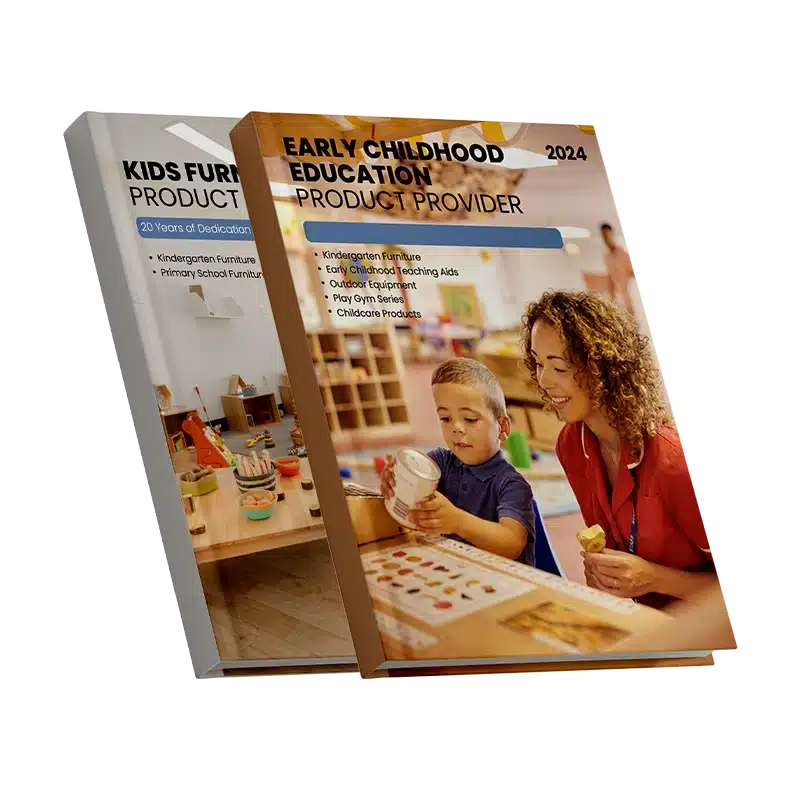
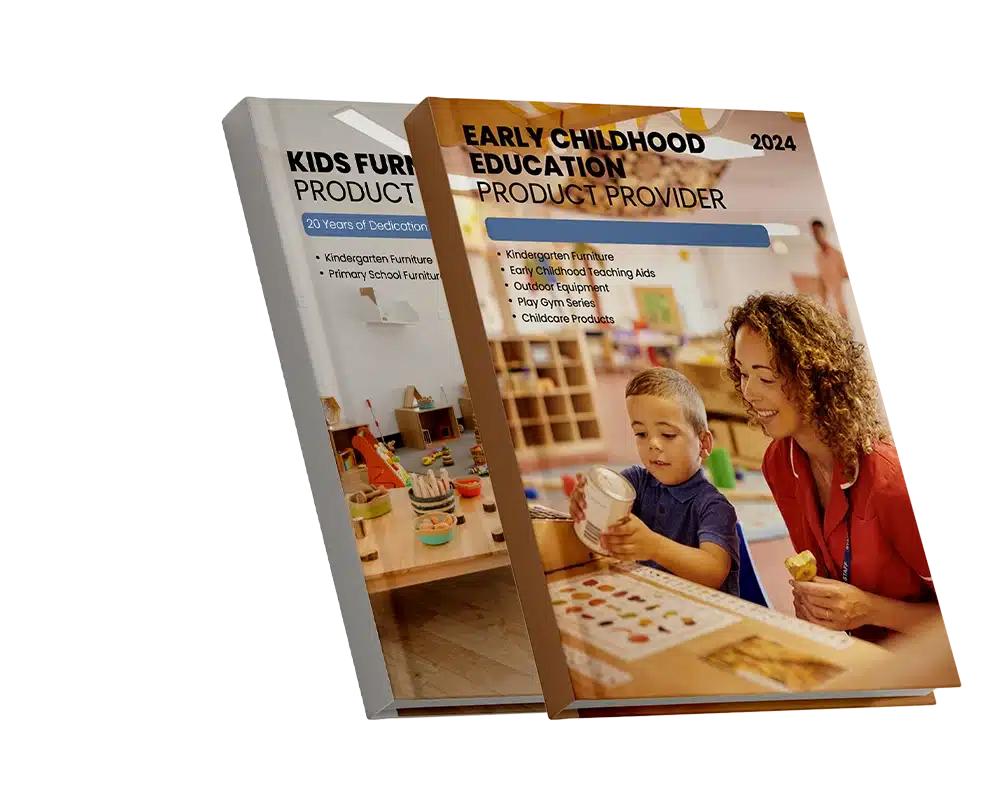
Examples of Montessori Art and Craft Activities
Now that we understand the difference between art and craft activities and the best materials to use let’s explore some practical Montessori-inspired activities that parents and educators can introduce at home or in the classroom.
Simple Art Activities for Toddlers
For young children, art should be about exploration, not perfection. These Montessori arts and crafts activities allow toddlers to discover textures, colors, and patterns through hands-on experiences.
- Finger Painting on Textured Paper
- Provides a sensory-rich experience as toddlers explore smooth, rough, and bumpy surfaces with paint.
- Enhances fine motor skills and color recognition.
- Nature Stamping with Leaves and Flowers
- Collect leaves or flowers and dip them in paint before pressing them onto paper.
- Encourages a connection with nature while engaging in creative expression.
- Salt Dough Handprints
- Simple homemade salt dough lets toddlers create handprint keepsakes.
- Improves tactile sensory exploration and introduces them to craft-based creation.
Advanced Craft Projects for Older Children
Montessori arts and crafts album activities can become more structured as children grow, helping them refine their technical skills while embracing creativity.
- Weaving with Fabric Scraps
- Encourages patience, hand-eye coordination, and an introduction to textile arts.
- Uses recycled materials, reinforcing Montessori’s sustainability values.
- Handmade Paper with Recycled Materials
- Teaches children about sustainability while making unique, textured paper.
- Integrates practical life skills into artistic expression.
- Clay Modeling and Pottery
- Allows children to sculpt and mold figures, encouraging three-dimensional creativity.
- Develops hand strength and precision, which are essential for writing skills.
These activities demonstrate how Montessori art and craft can blend creativity with skill development, ensuring children learn through exploration while gaining practical abilities.
How Montessori Art and Craft Foster Creativity and Independence
One of the most valuable aspects of Montessori art and craft is its ability to cultivate creativity and independence in children. Unlike traditional art programs focusing on step-by-step instructions, Montessori art and craft activities allow children to explore materials, experiment with techniques, and express themselves without judgment. This open-ended approach empowers children to become confident creators and independent thinkers.
Promoting Independent Exploration
In a Montessori art and craft setting, children are encouraged to make their own choices—from selecting materials to deciding how to use them. Instead of being told, “Draw a tree like this,” they are given tools and inspiration to create their own vision of a tree or something entirely different.
How Montessori Encourages Independent Art Exploration:
- Self-directed workstations – Children choose materials from an organized, accessible art space.
- No predefined outcomes – Unlike traditional crafts with fixed templates, Montessori arts and crafts emphasize free-form creativity.
- Minimal adult interference – Teachers and parents observe rather than instruct, allowing children to solve artistic challenges independently.
This approach fosters confidence and decision-making skills essential for children’s overall development.
Nurturing Problem-Solving Skills
Montessori art and craft activities don’t just promote creativity—they also help children develop critical thinking and problem-solving abilities. Children experiment, test ideas, and find solutions independently as they engage with different materials.
For example:
- A child struggling to glue pieces of fabric together might discover that layering the glue works better than applying it in one thick layer.
- Another child working with clay might realize that water helps smooth rough textures.
By facing and overcoming these challenges, children learn resilience, patience, and adaptability, skills that extend far beyond the art studio.
The Role of Observation in Montessori Art Activities
Observation is crucial in guiding children’s creative development in Montessori art and craft. Unlike traditional education models where teachers actively instruct, Montessori educators observe and adapt based on each child’s needs and interests.
Teachers as Observers
Rather than dictating what a child should create, Montessori teachers watch how children interact with materials, stepping in only when necessary. This method:
- Respects a child’s natural learning process, allowing them to explore independently.
- Helps educators identify interests, guiding them to provide the right tools for further creative exploration.
- Encourages self-correction—instead of pointing out “mistakes,” teachers let children refine their techniques.
For instance, if a child repeatedly chooses natural materials like leaves and stones, a Montessori teacher might introduce more nature-based Montessori art and craft activities, such as leaf printing or rock painting.
Adapting Activities Based on Observations
Educators and parents can carefully observe children’s artistic choices to tailor Montessori arts and crafts experiences to suit individual needs better.
How Observation Helps Adapt Art Activities:
- If a child seems hesitant to start painting, the teacher might offer a variety of brushes and sponges to make the activity more inviting.
- If a child enjoys storytelling, introducing story-based Montessori art and craft activities (such as drawing their favorite characters) can enhance their engagement.
- If a child shows advanced fine motor skills, they can be introduced to more intricate craft projects, such as weaving or embroidery.
This flexible approach ensures that Montessori art and craft activities remain meaningful, engaging, and developmentally appropriate for each child.
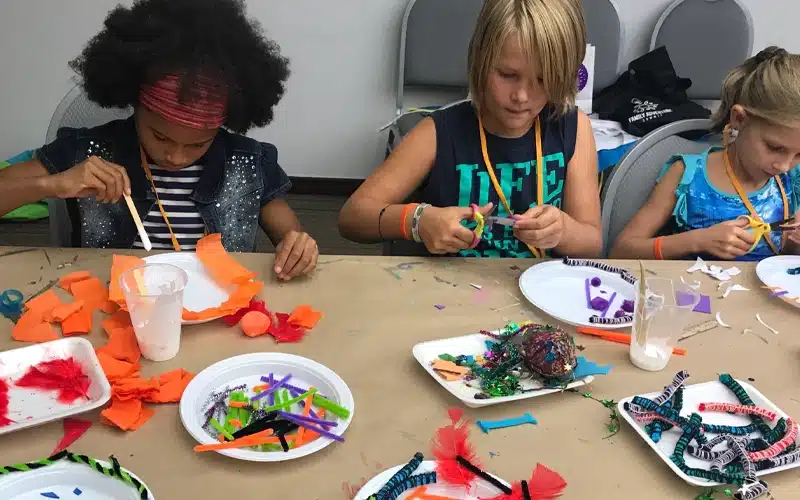
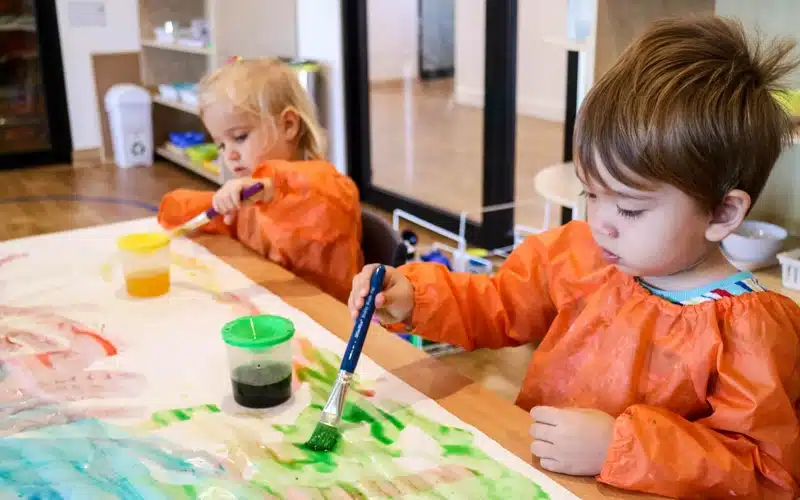
Integrating Art and Craft into Montessori Daily Routines
In Montessori education, art is not a separate subject but an integral part of daily life. Instead of being limited to “art time,” children engage in Montessori arts and crafts naturally through activities that blend creativity with practical life skills.
Art in Practical Life Activities
One of the key principles of Montessori art and craft is its connection to real-world experiences. Many everyday tasks incorporate artistic elements, allowing children to develop creativity while engaging in meaningful work.
Examples of Practical Life Art Activities:
- Cooking & Food Art – Decorating cookies, arranging colorful fruit platters, or making pasta necklaces.
- Gardening & Nature Art – Pressing flowers to create botanical prints, making seed mosaics, or painting flower pots.
- Sewing & Weaving – Simple stitching projects, making felt decorations, or hand-weaving small baskets.
By integrating Montessori art and craft activities into daily routines, children see art as a natural expression rather than just a structured task.
Benefits of Art and Craft for Social and Emotional Development
In Montessori art and craft, the creative process is not just about making something visually appealing—it is a powerful tool for social and emotional growth. Engaging in Montessori art and craft activities helps children develop emotional intelligence, strengthen interpersonal relationships, and build self-confidence.
Enhancing Social Skills Through Group Art Projects
Social interaction is a key aspect of Montessori arts and crafts. Many Montessori-inspired activities encourage collaboration, where children learn to communicate, share, and work as a team. Unlike traditional education, where children often complete individual projects, Montessori emphasizes group projects that require cooperation and mutual respect.
How Group Art Activities Support Social Development:
Collaborative Mural Painting – Children work together on a large painting, discussing colors, shapes, and artistic ideas while respecting each other’s contributions.
Joint Sculpting Projects – Groups of children create a sculpture using clay, requiring negotiation, turn-taking, and compromise.
Storytelling Through Art – One child starts a drawing and then passes it to another who adds elements, fostering interaction, teamwork, and creative thinking.
Through these activities, children learn patience, cooperation, and active listening, all essential social skills that extend beyond the art studio.
Emotional Growth Through Self-Expression
One of the most significant advantages of Montessori art and craft is that it provides a safe space for emotional expression. Young children may struggle to verbalize complex emotions, but through painting, drawing, and crafting, they can communicate their feelings in a non-verbal yet meaningful way.
- A child experiencing excitement might use bright, energetic strokes in their artwork.
- A frustrated child might press harder with crayons or sculpt jagged edges in clay.
- A quiet, reflective child might create soft, blended watercolor paintings.
By allowing children to explore emotions through artistic expression freely, Montessori arts and crafts help them process experiences, relieve stress, an
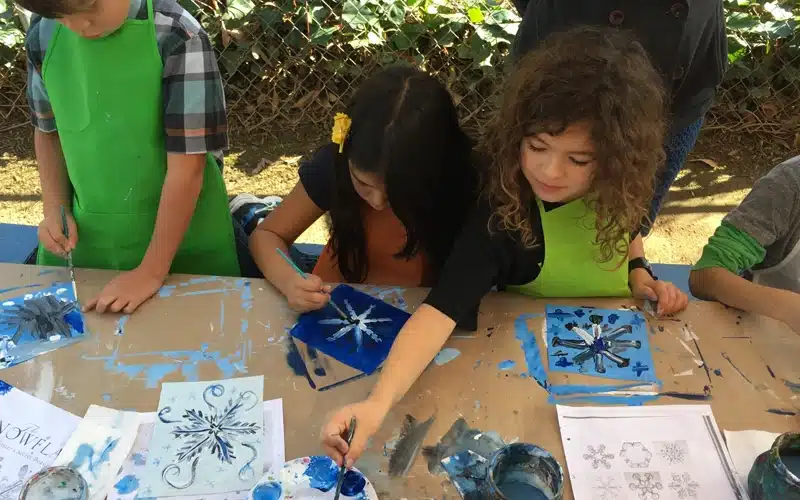
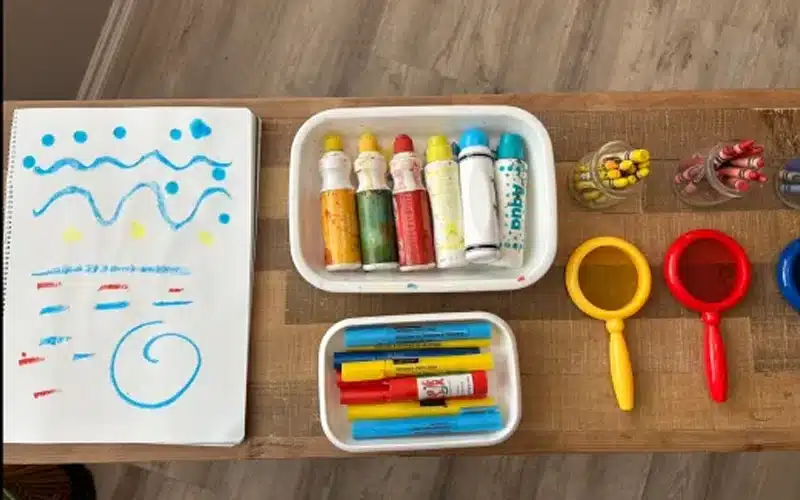
Challenges and Considerations in Montessori Art and Craft
While Montessori art and craft activities offer numerous benefits, implementing them effectively can be challenging. Many parents and educators struggle with material accessibility, maintaining child-led exploration, and creating an optimal environment.
Overcoming Resource Limitations
One of the biggest challenges in Montessori arts and crafts is accessing high-quality, natural, and non-toxic materials. Unlike traditional school art programs that rely on pre-made craft kits, Montessori emphasizes using real, organic, and sustainable materials.
| Challenge | Montessori-Based Solution |
|---|---|
| High cost of Montessori materials | Use nature-based elements (leaves, twigs, flowers) instead of expensive craft supplies. |
| Limited access to specialty art tools | DIY art materials (e.g., homemade watercolors, cornstarch glue) can replace store-bought products. |
| Sustainability concerns | Incorporate recycled items (cardboard, fabric scraps, old magazines) to promote eco-friendly creativity. |
| Space constraints | Set up portable Montessori art stations, using small trays with rotating supplies. |
| Balancing structure with creative freedom | Offer both guided craft activities and free art sessions, ensuring a blend of skill-building and exploration. |
By thinking resourcefully, parents and educators can create a rich Montessori art environment even with limited materials or budgets.
Parent Involvement in Montessori Art and Craft
Montessori education is not limited to the classroom—it extends into the home, where parents play a vital role in nurturing creativity through Montessori art and craft. By creating an inspiring and accessible environment, parents can support independent artistic exploration, encourage self-expression, and help children develop essential fine motor and problem-solving skills.
One of the most effective ways parents can engage in Montessori arts and crafts is by setting up a dedicated Montessori-inspired art space at home.
Creating a Montessori Art Space at Home
Designing a Montessori art and craft area at home doesn’t require ample space or expensive supplies. The key is to make it accessible, organized, and child-centered, allowing children to explore their creativity freely.
Key Elements of a Montessori Art Space:
Low, Open Shelving for Materials – Art supplies should be stored on open shelves at the child’s eye level, allowing them to choose what they need independently. Using baskets, trays, or jars can help keep materials neatly organized.
A Child-Sized Table and Chair – Providing a comfortable, age-appropriate workspace ensures children can create art without restrictions.
Eco-Friendly and Natural Art Supplies – Montessori art and craft activities emphasize the use of safe, non-toxic, and natural materials, such as:
- Beeswax crayons instead of synthetic wax crayons
- Water-based, plant-derived paints instead of chemical-heavy alternatives
- Wooden brushes and tools for a more tactile experience
Rotation of Art Supplies – Montessori encourages rotating materials every few weeks to maintain interest and excitement instead of overwhelming children with too many options.
A Display Area for Artwork – Showcasing a child’s creations on a designated art wall or corkboard fosters pride and motivation, reinforcing their sense of accomplishment.
Practical Tips for Parents to Encourage Montessori Art and Craft at Home
- Let Children Take the Lead—Instead of giving them strict instructions, Let them choose their materials and decide how they want to express themselves.
- Focus on Process, Not Product – Encourage children to enjoy creating without worrying about making something “perfect.”
- Incorporate Nature into Art – Use leaves, flowers, pebbles, and other outdoor materials in Montessori arts and crafts activities, reinforcing a connection with the natural world.
- Create a Calm, Mess-Friendly Zone – Set up a space with washable surfaces, keeping aprons, sponges, and towels handy to make cleanup easy and stress-free.
- Model Creativity – Engage in Montessori art and craft activities alongside your child, demonstrating curiosity and a willingness to explore new artistic techniques.
Why a Montessori Art Space Matters
A well-designed Montessori-inspired art space allows children to:
- Express emotions and thoughts freely
- Develop fine motor and problem-solving skills through hands-on activities
- Gain confidence and independence in their creative decisions
- Enjoy a stress-free, process-oriented approach to art
By setting up a Montessori-friendly art and craft environment, parents empower their children to become self-sufficient, imaginative, and engaged learners—one brushstroke at a time.
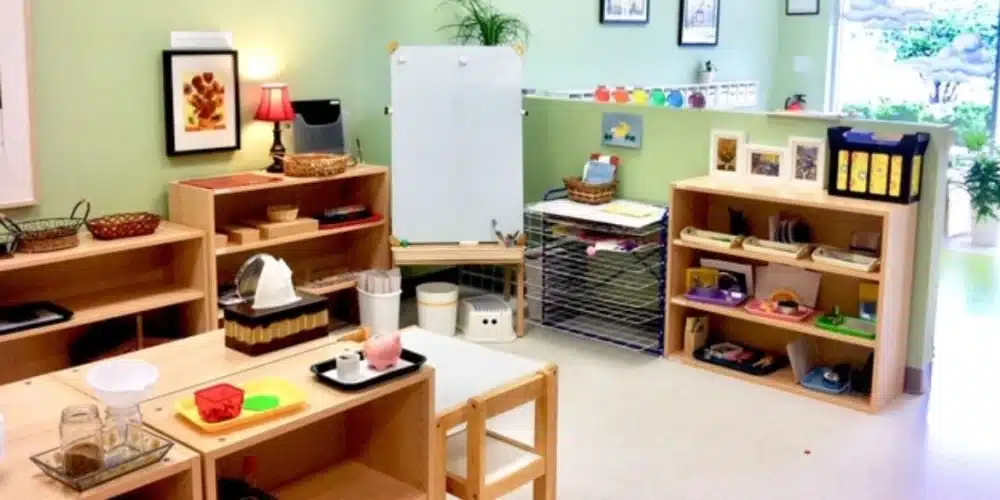
Montessori art and craft is more than just an avenue for creativity—it is a powerful tool for cognitive, emotional, and social growth. Montessori arts and crafts nurture independent thinking, problem-solving skills, and self-expression in ways that traditional art education often overlooks by emphasizing process over product, self-directed exploration, and hands-on engagement.
From the fundamental principles of Montessori art to practical activities and material selection, we have explored how this approach fosters creativity, independence, and a love for learning. Through group art projects, children develop social skills; through self-expression, they enhance emotional intelligence; and through Montessori-inspired art spaces at home, parents can create a supportive environment for artistic growth.
Key Takeaways from Montessori Art and Craft:
- Encourages Creativity & Exploration – Children can experiment with materials, techniques, and artistic ideas without constraints.
- Develop Fine Motor & Problem-Solving Skills – Cutting, threading, sculpting, and painting refine motor coordination.
- Supports Emotional & Social Growth – Art provides an outlet for self-expression, while collaborative projects build teamwork and communication skills.
- Integrates Seamlessly into Daily Life – Montessori-inspired art is not a separate activity but a natural part of everyday experiences, from nature walks to home crafting.
Introducing Montessori art and craft activities early lays the foundation for a child’s lifelong creativity, confidence, and independent learning. Whether in a Montessori classroom or at home, the key is to provide an environment that encourages exploration, curiosity, and self-expression.
So, gather some beeswax crayons, natural brushes, and recycled materials—and let your child embark on their artistic journey the Montessori way!

